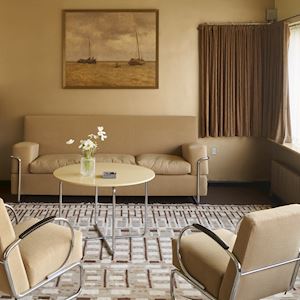
04. Sitting room
We kindly ask you not to touch the objects in this room. They are art objects from the museum’s collection. We would also ask you not to sit on the windowsills. They’re made of glass and break rather easily. This huge area actually consists of three rooms: the living room, the library and the dining-room, which can be separated from each other using a partition and a curtain. The use of partitions is typical of the Nieuwe Bouwen movement, as are the windows stretching the whole length of the facade, around 15 metres of glass. This is because of the construction of the house, which consists of a skeleton of steel joists. As a result, none of the inner or outer walls is load-bearing, so there are no limits on the amount of glass. The joists are actually clearly visible: they're the square columns by the windows, clad in panes of light yellow glass. When Mr and Mrs Sonneveld moved here, they left all their old furniture behind and bought everything new to match the architect-designed interior. One acquaintance of the family says that they weren’t even allowed to keep any Persian rugs. Instead, they chose tubular steel furniture because it was modern, light and open. The orange armchairs in the sitting and workrooms are replicas. You can also see some of the old furniture such as the bureau in front of the window where Mrs Sonneveld wrote her letters, and the Steinway grand piano played by her elder daughter Puck, who was very musical. The choice of colours is unusual: they consist mainly of shades of beige and brown, combined with a single pale yellow accent from the bureau chair. These colours are quite different to the grey, black and white that was typical of the Dutch Fuctionalism, or Nieuwe Bouwen movement (?), and are more reminiscent of luxurious French Art Deco style. The combination of textures and materials is also surprising: smooth tubular steel chairs, a wool carpet, plush curtains, and the distinctly unusual brown wall with its striking metallic paint.
If you'd like to know more about the Nieuwe Bouwen movement, press A. To hear more about the furniture, soft furnishings and works of art in this room, press C.


Sonneveld House is one of the best-preserved houses in the Dutch Functionalist style. The villa was designed in 1933 by architecture firm Brinkman and Van der Vlugt for Albertus Sonneveld, a director of the Van Nelle Factory.
- Museumpark 25
- Rotterdam Netherlands
- 010 440 1200
- nieuweinstituut.nl
